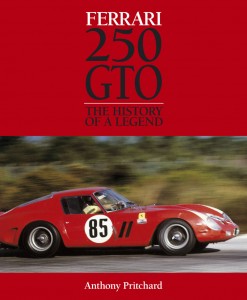Three Million Miles in a Volvo and Other Curious Car Stories
50 Fascinating Lives with Cars
 by Giles Chapman
by Giles Chapman
“At first, she’d love to drive to Montreal with me for lunch, which is 400 miles each way. Then, when she became a travel agent, she preferred to fly, and meet me there.”
—Irv Gordon, on how 800-mile days spent in his Volvo P1800S had finite appeal to Mrs. Gordon
If you’re a car guy you’ll know of Giles Chapman. He’s a busy man—he has been the editor of Classic and Sports Car magazine, regular contributor to others including Autocar and Octane, and he has also written over fifty books.
Automobilia has seen a glut of absurdly priced titles recently, some little more than vanity projects commissioned by rich owners of expensive classics. But that isn’t Chapman’s territory—his most successful book, My Dad had One of Those, co-authored by Richard Porter, sold 190,000 copies and cost Peanuts.
Three Million Miles is in the same vein. This compact (8 x 5″) 240-page book will cost about the same as Starbucks’ flat whites for four. But it will last much longer, as there are fifty chapters worth of potted biographies to digest. Starting with Thunderbirds puppeteer Gerry Anderson and ending with Brooklands fast lady Elsie “Bill” Wisdom, the book spans familiar names such as Cecil Kimber, Albrecht Goertz and Victor Gauntlett, and lesser known (if equally interesting) characters like steam car zealot Peter Pellandine and super salesman Raymond Way. Incidentally, I loved Way’s marketing schtick of giving customers Jamaican cigars with “Jolly Good Luck! Raymond Way Motors of Kilburn” printed on the tube. Did lady customers get a cigar too?
 Three Million Miles packs anecdotes aplenty, induces many a grin, and triggers lots of “I never knew that!” moments. And if it’s more Beetle than Lexus, it is still fit for purpose, and the production values just reflect the budget price. In look and feel the paper evokes another era and it’s a stranger to color. But even though the pictures are small and grainy black and whites, who cares? I’m happy enough with tiny period shots of accessories king Les Leston sporting his very 1970s sideburns or “Flaminio Bertoni sculpting Traction Avant model.”
Three Million Miles packs anecdotes aplenty, induces many a grin, and triggers lots of “I never knew that!” moments. And if it’s more Beetle than Lexus, it is still fit for purpose, and the production values just reflect the budget price. In look and feel the paper evokes another era and it’s a stranger to color. But even though the pictures are small and grainy black and whites, who cares? I’m happy enough with tiny period shots of accessories king Les Leston sporting his very 1970s sideburns or “Flaminio Bertoni sculpting Traction Avant model.”
The approach the author has taken works best when less well-known figures are featured. Describing the likes of Vincenzo Lancia, Louis Renault, or Peter Sellers (“Titled car wishes to dispose of owner”) in fewer than 1500 words cannot amount to much more than amuse-bouches, and this brevity serves mainly to whet the reader’s appetite for more. But it is when the characters are smaller fish in modest ponds that Chapman excels. There is much to savor—eccentricity (Panther founder Robert Jankel), entrepreneurship (arch wheeler dealer Mario Tozzi-Condivi, above) and also wild, out-there ambition, perhaps none more than Nigerian-American artist David Gittens’ vision for his brainchild, the bizarre Ikenga GT. Not even Lamborghini Countach creator Marcello Gandini’s wildest fever dreams ever stretched to a car that was “a contemporary African mask-on-wheels that faced skyward to the Spirit.”
 And while many profiles are rich in humor, the story of Nils Bohlin made me sober up PDQ. Exotic cars venerated for their performance and style are often the principal currency of our conversations, with driver safety no more than an unwelcome gate crasher. The near cargo cult obsession with James Dean’s Little Bastard Porsche 550, let alone with any vehicle the (so-called) King of Cool Steve McQueen ever so much as touched exert an irresistible pull on car people. But consider how many of us, me included, are forever in the debt of Nils Ivar Bohlin. No? Me neither. It’s a name that hardly resonates like Enzo Ferrari or Ayrton Senna’s but his invention almost certainly saved my life and maybe yours too. Got it yet? Yup, the diligent, sensible, and possibly charisma-free Herr Bohlin was the Volvo engineer who invented the lap and diagonal seatbelt that is still fitted to every new car made. And that was thanks to Volvo’s extraordinarily philanthropic gesture in making the patent free to all. Incidentally, I also learned that the first users of makeshift safety belts weren’t sober Swedes but American doctors in the 1930s “after seeing first- hand the appalling injuries unrestrained drivers suffered in crashes.”
And while many profiles are rich in humor, the story of Nils Bohlin made me sober up PDQ. Exotic cars venerated for their performance and style are often the principal currency of our conversations, with driver safety no more than an unwelcome gate crasher. The near cargo cult obsession with James Dean’s Little Bastard Porsche 550, let alone with any vehicle the (so-called) King of Cool Steve McQueen ever so much as touched exert an irresistible pull on car people. But consider how many of us, me included, are forever in the debt of Nils Ivar Bohlin. No? Me neither. It’s a name that hardly resonates like Enzo Ferrari or Ayrton Senna’s but his invention almost certainly saved my life and maybe yours too. Got it yet? Yup, the diligent, sensible, and possibly charisma-free Herr Bohlin was the Volvo engineer who invented the lap and diagonal seatbelt that is still fitted to every new car made. And that was thanks to Volvo’s extraordinarily philanthropic gesture in making the patent free to all. Incidentally, I also learned that the first users of makeshift safety belts weren’t sober Swedes but American doctors in the 1930s “after seeing first- hand the appalling injuries unrestrained drivers suffered in crashes.”
The book is written in an easy-going, accessible style and is often punctuated by wry asides. It’s the right approach for this book and my only cavil is that the prose does sometimes have the whiff of journalese. Take the very excitable dust cover text: “A whistle stop tour of fifty fascinating petrolheads,” “MEET the Prince of Darkness . . .” (i.e. the ever reviled Joseph Lucas)—but that perhaps just reflects the intended market? Giles Chapman is a British author, of course, and I suspect some of the pop culture references might not enjoy an easy passage across the Atlantic. But if the reader hasn’t ever seen, or even heard of The Sweeney* TV series, then a quick Google will tell you all you need to know, and YouTube will offer a trip back to the Seventies, when the cops chain-smoked and the robbers drove Mk 2 Jaguars. Sideways, usually.
This is a much better book than the rather shouty cover suggests. It isn’t a book to read at one sitting; it’s for those times when you arrive for your appointment fifteen minutes early and you really can’t stomach another doom scroll on your iPhone. God knows there is enough bad news in 2024, but this charming little book is guaranteed relief and will soon have you immersed in another absurdly enjoyable four-page biography. Recommended.
*Sweeney, abbreviated from Sweeney Todd, which, in cockney rhyming slang, refers to the Metropolitan Police Flying Squad.
Copyright John Aston, 2024 (speedreaders.info)


 RSS Feed - Comments
RSS Feed - Comments






































































 Phone / Mail / Email
Phone / Mail / Email RSS Feed
RSS Feed Facebook
Facebook Twitter
Twitter